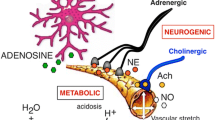Abstract
The purpose of the present study was to investigate changes in cerebral circulation during neurocardiogenic syncope (NCS). Twenty patients with a history of unexplained syncopes were studied over a 45 min period in a tilted position. Heart rate and arterial blood pressure were recorded non-invasively using Finapres. Cerebral blood flow velocity of both middle cerebral arteries was measured with transcranial Doppler (TCD). Ten patients (50%) developed a NCS during the tilt test, with a strong reduction in blood pressure (mean, 48/34 mmHg) and heart rate (mean, 54 beats/min). Simultaneously, diastolic blood flow velocities dropped to values close to zero. However, systolic blood flow velocities did not decrease. In consequence, the pulsatility index (PI) increased considerably from 0.93 to 2.01. The increase in PI suggests that there is a constriction of cerebral resistance vessels during NCS. Despite the drop in blood pressure and the putative increase in cerebrovascular resistance, systolic blood flow velocities remained unchanged in the TCD records. This fact can be explained by a lumen narrowing of the middle cerebral artery at the site of insonation. In conclusion, the typical changes in cerebral blood flow velocity during NCS are probably due to a strong constriction of both the proximal and the peripheral segments of cerebral arteries. It is clear that, in addition to vasodepression and cardiac inhibition, cerebral vasoconstriction is a further mechanism in the pathogenesis of a NCS.
Similar content being viewed by others
References
Barcroft H, Edholm OG. On the vasodilatation in human skeletal muscle during post-haemorrhagic fainting.J Physiol 1945;104: 161–175.
Shepherd JT, Vanhoutte PM.The Human Cardiovascular System. New York: Raven Press, 1980.
van Lieshout JJ, Wieling W, Karemaker JM Eckberg DL. The vasovagal response.Clin Sci 1991;81: 576–586.
Hackel A, Linzer M, Anderson N, Williams R. Cardiovascular and catecholamine responses to head-up tilt in the diagnosis of recurrent unexplained syncope in elderly patients.J Am Geriatr Soc 1991;39: 663–669.
Aaslid R (ed).Transcranial Doppler Sonography. Vienna: Springer, 1986.
Grubb BP, Gerard G, Roush K, Temesy-Armos P, Montford P, Elliott L, Hahn H, Brewster P Cerebral vasoconstriction during head-upright tilt-induced vasovagal syncope. A paradoxic and unexpected response.Circulation 1991;84: 1157–1164.
Fitzpatrick AP, Theodorakis G, Vardas P, Sutton R. Methodology of head-up tilt testing in patients with unexplained syncope.J Am Coll Cardiol 1991;17: 125–130.
Milnor WR.Hemodynamics. Baltimore: Williams & Wilkins, 1989.
Baumbach GL, Heistad DD. Effects of sympathetic stimulation and changes in arterial pressure on segmental resistance of cerebral vessels in rabbits and cats.Circ Res 1983;52: 527–533.
Raichle ME, Hartmann BK, Eichling JO, Sharpe LG. Central noradrenergic regulation of cerebral blood flow and vascular permeability.Proc Natl Acad Sci USA 1975;72: 3726–3730.
Bonvento G, Lacombe P, Seylaz J. Effects of electrical stimulation of the dorsal raphe nucleus on local cerebral blood flow in the rat.J Cereb Blood Flow Metab 1989;9: 251–255.
Mattle HP, Nirkko AC, Baumgartner RW, Sturzenegger M. Transient cerebral circulatory arrest coincides with fainting in cough syncope.Neurology 1995;45: 498–501.
Ungersböck K, Tenckhoff D, Heimann A, Wagner W, Kempski OS. Transcranial Doppler and cortical microcirculation at increased intracranial pressure and during Cushing response: an experimental study on rabbits.Neurosurgery 1995;36: 147–157.
Author information
Authors and Affiliations
Rights and permissions
About this article
Cite this article
Diehl, R.R., Linden, D., Chalkiadaki, A. et al. Transcranial Doppler during neurocardiogenic syncope. Clinical Autonomic Research 6, 71–74 (1996). https://doi.org/10.1007/BF02291226
Received:
Accepted:
Issue Date:
DOI: https://doi.org/10.1007/BF02291226



